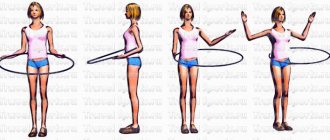Why exactly 10 thousand?
The figure appeared after the 1964 Summer Olympics in Tokyo. At that time, a sports boom arose in Japan, and a year after the Games, new Manpo-kei pedometers - translated from Japanese as “10 thousand steps” - went on mass sale. Their creator, Dr. Yoshiro Hatano, calculated how many steps per day bring the number of calories burned to approximately equal to the number consumed.
This stereotype was firmly entrenched first in the minds of the Japanese, and then throughout the world.
The Japanese doctor was right in many ways: 10 thousand steps (about 8 kilometers) is the most accurate guideline. For example, it was confirmed by the British Heart Foundation.
Pavel Evdokimenko: “10 thousand is truly the optimal number. In a person, especially an elderly person who walks more, the joints are overloaded. But, of course, there are no strict restrictions - you don’t need to count strictly 10 thousand and not a step more.”
How to properly run to lose weight?
In 1 minute of running at a comfortable pace, an average person burns 8.5 calories. Running for 30 minutes burns about 255 calories, which is the equivalent of a medium-sized apple with peanut butter. By comparison, a half-hour yoga session burns 120 calories. Before you start running 10 miles a day, keep in mind that you need to gradually increase your speed.
You might think that the more you run, the more calories your body will burn, but unfortunately, that's not entirely true. The body quickly adapts to the stress, and over time the number of calories burned will become less. This is where interval running comes to the rescue.
How many calories do 10,000 steps burn?
Many people strive to lose weight by walking. Since walking can be equated to long-term aerobic training that affects the breakdown of fat, this result is achievable (in combination with the right diet).
The pace of walking and the amount of excess weight are important (the more weight there is, the faster calories will be burned). Some pedometers have a calorie counting function, but you can do this calculation yourself using a specially developed formula
To do this, multiply the length of one step (in meters) by their number, then multiply by the person’s weight in kilograms, divide the resulting value by 2. The result will show the number of calories burned.
For example, a person weighing 80 kg with a stride length of 0.7 m walked at an average pace of 10,000 steps. Multiplying the last 2 numbers, we get the distance traveled - 7000 m. Multiply by weight 80 kg, and divide the result by 2. It turns out 280,000 cal or 280 kcal. This is the amount of energy a person burns after walking 10,000 steps. When walking fast, the same person can burn about 2 times more.
The effectiveness of losing weight through walking can be increased by using Nordic walking with poles. This style of physical activity has a number of advantages, since it loads not only the legs, but also the arms and shoulders. Involving the upper limbs in the walking process evenly loads most of the body's muscles.
How to calculate running efficiency based on heart rate?
It is believed that the average time spent running should be about 40 minutes. But beginners can first exercise for 15 minutes, gradually increasing the load. Experienced runners say that it is not so important how to start running as its continuation and completion. To keep your body in perfect shape, you will need to spend at least 100 minutes jogging a week.
The main role is played by the correctly chosen pace, which determines the pulse rate. Calculation of the individual load on the body while running is carried out in the following way:
- subtract your age from 220;
- subtract 50% from the obtained value;
- a normal pulse was obtained.
During running, the heart rate should slightly exceed the obtained value.
Alternative to fitness training
Walking as a form of fitness has a number of advantages and brings undoubted benefits to the body:
- does not require significant cash costs or investments, you can practice in comfortable clothes and shoes;
- Suitable for people who are overweight and have poor physical fitness;
- tones and strengthens the body, preparing the body for increased stress.
How to start walking
An unprepared person in pursuit of results should not take tens of thousands of steps a day, making excessive efforts - this will lead to tension and fatigue. You should start with short distances, gradually increasing the distance and speed of movement.
It is recommended to devote the first workout to building a track and studying your own data - how many steps are in 1 kilometer, how much time is needed to cover such a distance and calorie consumption, if the goal is not only to strengthen muscles, but also to lose weight. Next, you need to find out how much distance is covered during normal activities and movements - it is convenient to use a pedometer for this.
During the first week of classes, 1000 steps per day are added to the basic 1 km (an additional 32 calories are consumed). In the second week - by 1500, the third - 2000, gradually increasing the distance to 4 km (or 5,000 steps), while 150-160 kcal per day will be burned. After a month of training, adding 1000-1500 steps per day per week, the distance will increase to 10,000 steps, which burns 320-350 kcal.
Active weight loss
Walking 10,000 steps burns 320 calories per day, which translates to 2,240 calories per week or 250-300 grams of fat. At this rate, the possible loss per month is 1-1.5 kg. Strength training in this case is necessary in order to build muscle mass and increase passive energy expenditure.
How much should you walk a day?
The figures of 10,000 steps or 8 kilometers became popular after Japanese scientists declared the benefits of walking, but these values are not suitable for everyone and become surmountable. For sedentary people with low physical activity, even 2000 steps (1.5 km) will be a good result. By gradually increasing walking to 4000 steps (3 km), you can improve the condition of the cardiovascular, muscular and nervous systems. A daily distance of 5 kilometers (6250 steps) will tone the body and stimulate weight loss processes.
Covering 10,000 steps a day for different categories of the population will take different distances, which depends on the size of the step: one step is 0.4-0.8 meters. The walking workout will take 1-1.5 hours; it can be divided into several parts and completed throughout the day.
10 thousand steps a day is a reference figure, an approximate value to which we should strive. In any case, increasing your activity by 1,000–3,000 steps per day will have a beneficial effect on the body.
Questions for experts: how much do you need to walk to lose 1 kg?
Companies dealing with the question of how many steps a day should be taken to lose weight, developing pedometers, sports bracelets, and applications, take 10,000 steps as a basis.
A Harvard study points to a link between reduced human mortality and walking 6,000 steps per day. During each day, a person takes about 3000–4000 steps during normal activities. Therefore, when combining the minimum amount (6000) necessary for health, and 4000, done “in any case,” the recommended number is 10,000.
But each person is individual. Therefore, the answer to the question of how many steps a day should be taken to lose weight for women and men is different for everyone. In childhood, 10,000 steps are not enough, because the child walks and runs much more; in old age this figure is quite high. Therefore, you don't need to achieve the exact number of steps at any cost (although they are a good indicator of activity). Instead of counting, it's better to focus on time. To get rid of 1 kg per week, 30 minutes of walking daily is enough.
Why 10,000 steps
Now many people consider the expression that if you walk 10,000 steps a day, you can live about 100 years, some kind of eastern wisdom that has existed from time immemorial. In fact, everything is not so prosaic. About 50 years ago, Yoshiro Hatano wrote a research paper on the benefits of walking, which became the basis for the creation of the first electronic step meter. This one-of-a-kind gadget was called Manpo-Kei, which in Japanese literally translates to “10,000 step meter.” Thus, this theory was initially just a successful marketing ploy, with the help of which tens of thousands of devices were sold.
Hatano was inspired to create a pedometer by thinking about the quality of life of his compatriots. He noticed that over time, the Japanese began to adopt the behavior habits of the Americans, who predominantly lead a sedentary lifestyle and do not think much about maintaining their health. To increase the activity of the population, Yoshiro began to convince people of the benefits of walking: if a person can walk more than 4,000 steps a day, he will burn more calories, which means his body will always be fit and healthy. This statement did not go unnoticed, and soon thousands of people began to increase their physical activity by measuring the number of steps.
Despite the fact that the theory initially appeared as part of an advertising campaign, scientists subsequently conducted the necessary studies that were able to prove the positive effects of 10,000 steps a day on the body. In order for the muscles to always be in good shape and the cardiovascular system to work like a clock, a person should take about 10-12 thousand steps during the day. However, 10,000 steps is how many in kilometers? Adjusting for step length, on average you need to walk about 6-8 km per day. Not much, however, this distance can become difficult for city residents.
In order to sleep longer, on weekdays a person leaves a little time in the morning in order to get to the office as quickly as possible. At the end of the day, he wants to quickly be home and relax, lounging on the sofa. This lifestyle is not very beneficial for the body and sooner or later will cause a lot of discomfort for health. For comparison, our distant ancestors covered an unimaginable distance of 20 km a day, and they would have lived happily ever after if not for other negative factors of that environment. To keep your body healthy, you can replace public and personal transport with walking. If you can walk to work in the morning and evening, then why not take a walk and benefit your body?
Training program
If you are interested in how much you need to run to lose 1 kg or 10-15 kg, we will advise you to choose a program and then carefully follow its steps. Such schemes take into account both energy costs and duration of training, and also divide the entire schedule into the required number of days (months), so they are convenient.
Here are some popular programs:
If you are not pursuing the goal of losing weight, and you are interested in how much you need to run a day for health, end the workout when you feel that it has ceased to be enjoyable. Always go out on the track in a good mood and never force yourself to do exercises.
How much should you walk a day?
We have already said: to be healthy, you must play sports. And the simplest and most accessible form of it is walking. We tried to calculate how many steps there are in 1 kilometer (as you know, there are 1000 meters, and there should be approximately the same number of steps). However, the question immediately arises about how many kilometers you need to walk a day in order not to have health problems. The 10,000 steps rule is quite popular. This norm came to us from Japanese everyday life. However, questions arise again. And if a person ate a hamburger or ice cream, should this norm be increased? Or can I leave it the same?
In fact, this figure came to us from ancient times, when the Japanese moved much more on foot, and their diet was much healthier. Therefore, this was only a guideline for a healthy lifestyle. Today, doctors are faced with the fact that for many people walking even 2000 steps a day becomes problematic. It is for these people that the desire to cover a little over eight kilometers every day is most significant. The bar should be raised gradually so that there is no temptation to quit this venture.
Is it possible to lose weight if you walk 5 km a day?
We must admit that walking will not ensure weight loss in a month. Fat is the body's fuel. 335 kcal equals approximately 37 g of pure fat, which corresponds to approximately 50 g of body weight. Therefore, if you walk for 20 days, you can lose 1 kg. But this will be 1 kg of fat, not water, as with most other potentially healthy weight loss methods.
If you can turn walking into a regular ritual (at least 6,000 steps of continuous walking per day), you've won: if you walk 5 days a week, you can lose 12 kg per year.
Why exactly 15,000 steps?
In a joint study, Time spent in sedentary posture is associated with waist circumference and cardiovascular risk. Three British universities determined the relationship between how much a person walks, sits and stands and the risk of heart disease.
The study involved postal workers from Glasgow: 55 office workers and 56 postmen who delivered mail, mostly on foot. All participants had their body mass index, waist size, blood sugar and cholesterol levels measured - all of these indicators are risk factors for the development of heart disease.
Study participants who spent most of the day sitting had higher body mass index, sugar and cholesterol levels compared to those who moved more.
In fact, for every additional hour spent sitting more than 5 hours a day, subjects increased their risk of heart disease by 0.2%.
Workers who walked 15,000 or more steps each day or stood for 7 or more hours had a normal body mass index, an average waist circumference, and a low risk of metabolic syndrome.
Metabolic syndrome - an increase in visceral fat mass, a decrease in the sensitivity of peripheral tissues to insulin and hyperinsulinemia, which disrupt carbohydrate, lipid, purine metabolism, as well as arterial hypertension.
"Wikipedia"
Moreover, the risk of cardiovascular disease among mobile workers was significantly lower than among those who walked fewer than 15,000 steps per day.
The researchers suggested that this is the number of steps that should be targeted to reduce the likelihood of developing heart disease.
Walking for health and weight loss
The main motivation is visible changes that quickly appear during normal walking.
The benefits of walking for your figure and health:
- improved physical fitness;
- life extension;
- improved mood (when walking, the hormone serotonin is produced);
- strengthening bones and joints;
- prevention of osteoporosis;
- strengthening the heart, reducing the risk of heart disease;
- brain oxidation, improvement of memory, intellectual abilities;
- strengthening muscles and heart;
- body weight loss;
- activation of all muscle groups;
- supplying oxygen to the body’s cells, which facilitates better elimination of harmful metabolites;
- strengthening stabilizing muscles, including the outer and inner thigh muscles (when walking on uneven surfaces);
- lowering cholesterol levels, high blood pressure;
- slowing down the development of arthrosis;
- support of vascular elasticity;
- reduction of anxiety, depression.
Walking also burns calories. 30 minutes of brisk walking equals:
- 15-minute climb up the stairs;
- 30 minutes of gardening;
- hourly washing of windows and floors;
- 15-minute snow removal.
The positive effect of walking on the body appears after 3 months, when the level of dangerous fats, blood sugar, blood pressure decreases, and overall physical endurance increases.
Training in the heat: how much to drink, how to eat, do you need a cap?
The main advantage of walking is its accessibility. There is no need to buy equipment, special clothes, even a pedometer can now be easily installed on any smartphone.
Pavel Evdokimenko: “Walking is very useful, the best remedy against stress. I always tell patients that they need to walk - this is natural for a person who, by evolutionary nature, is a hunter and gatherer. The more you walk, the faster you recover from any illness.
If you are sick or have high blood pressure, your blood pressure will go down. Heart problems - go. Prostatitis - all the more walk. This is also the release of certain hormones, for example, cortisol. Ideal for maintaining health."
Basic Rules
There are three pillars of running training. These are regularity, nutrition, duration of training. If at least one of these elements falls out of your attention zone, then you will not see the result.
You should definitely keep these three points in mind. Without regularity, you won’t be able to lose weight; an incorrect diet will also be an obstacle to correcting figure flaws. It is also obvious that a short workout will, unfortunately, not be effective enough to achieve quick results.
Therefore, you will have to sweat:
- firstly, go for a run at least twice a week (less often it simply doesn’t make sense; ideally – 5 times a week);
- secondly, adjust your diet so that the number of calories burned exceeds the value of your daily food;
- thirdly, run for at least an hour (while carefully monitoring your well-being; if palpitations appear, switch to a calm walk).
However, a training period longer than an hour is also not preferable; you may experience muscle loss.
What should be the running speed for weight loss? Experts recommend focusing on the figure 6-7 km/h. However, if you are just starting to train, then start with a mixed technique: run while you have the strength, then start walking and rest.
As soon as you gain strength, start easy running again, and so on. Gradually increase the running periods and try not to lose speed throughout the distance.
Before you go for a run, do not forget to warm up to avoid injuries: do warm-up exercises for the legs (rotational movements, squats), breathing exercises with rotation of the arms.
Jogging through dusty streets is unlikely to improve your health. Choose a clean, pleasant place for you: a beautiful park, forest, stadium. In such a place, it will be easier for you to concentrate on running, it will be easier to breathe, and you will have more energy for training. If possible, avoid running on asphalt or invest in quality running shoes.
How to do
We cannot give any new advice, everything is trivial: use the stairs instead of the elevator. Get up from your desk every hour. Do exercises. Take a walk at lunchtime.
Park farther away and get off one stop earlier. Play with your children and get some fresh air before bed. It is these small movements that make up the overall activity. He walked here, moved around here, and, lo and behold, he’ll add up to ten thousand steps.
For a more active workout, add weight, for example, take a backpack with 2 or more kg. Fill it with water bottles, sandbags or kitty litter. This will distribute the weight evenly.
Important: in this case, the backpack should be located in the upper back so that the load on the lower back is not negative. If you lead a sedentary lifestyle (and especially if you are no longer young), then do not try to achieve the feat of jumping from 5,000 to 10,000 steps in one day
Be careful and increase the pace gradually, for example, 1000 steps per week
If you lead a sedentary lifestyle (and especially if you are no longer young), then do not try to achieve the feat of jumping from 5,000 to 10,000 steps in one day. Be careful and build up the pace gradually, for example, 1000 steps per week.
And, of course, Nordic walking - it uses 90% of the muscles of our body and increases calorie consumption by up to 46% than with normal walking. Poles help reduce stress on the ankle, knee and hip joints.
In general, such a load is the best option for health, we have been planning to write an article about this for a long time, we need to hurry up. The only drawback is the purchase of equipment (but again, Ali has quite decent poles) and the rather complex technique.
View more details
Walking for weight loss is a special way
One of the options for walking sports is Nordic walking. Step counting is not considered here and is not controlled. This sport is less demanding than running, but is no less effective. It uses even those muscle groups that are not affected during normal walking.
Nordic walking strengthens not only the lumbar muscles, but also the back, neck, and shoulder muscles, which improves posture. Engaging the upper body increases heart rate and improves blood circulation.
This sport increases calorie intake by about 20–25%. During normal walking, 800–1000 kJ are burned per hour; during Scandinavian walking, this figure increases to 1300 kJ.
Nordic walking does not put stress on the joints or spine. This is an aerobic activity that has a positive effect on blood pressure. It is recommended:
- obese people;
- women;
- men;
- children;
- youth;
- middle-aged and elderly people.
It can be done at any time of the year. Nordic walking is also suitable for people with chronic lung diseases. It is recommended for patients with osteoporosis (helps maintain a straight, flexible spine).
This sport has versatile effects on the musculoskeletal system, relieves joint pain, and stabilizes the musculoskeletal system.
Nordic walking is not limited by time; it is most often carried out in nature, which has a positive effect on the psyche - improves mood, relieves stress. But it is important to use the correct technique and the length of the poles. The thoracic spine should be straight enough to allow the torso to rotate well.
If you don't know where to start, talk to an instructor and find Nordic walking groups in your area. This is a social sport where you can make new friends and go out together.
Don’t forget about staying hydrated and stretching your muscles before and after exercise.
How to walk correctly?
Pavel Evdokimenko: “The main point is that to achieve the maximum health-improving effect, you need to walk at a brisk pace.”
There are a few more important rules:
• it is best to overcome 10 thousand in one go. This way the body and cardiovascular system will receive the necessary load, and the muscles will warm up.
If you divide the route into segments with frequent breaks (walk a little to the stop, then to work, back in the evening, stop at the store on the way) - the benefits will be much less. But this option is also suitable if it is not possible to move 8 kilometers in a row.
• the technique works if you use it every day - without consistency it is almost useless;
• it is better to go on an empty stomach;
• you can’t slouch – when walking, your back should be straight, your shoulders should be spread to the sides, and your arms should be swinging freely;
• correct breathing – inhale through the nose, exhale through the mouth. There is no need to talk while walking - it will disrupt the rhythm.
The agony of choice
The question is often asked: running or cycling - which is better? Cycling is also an aerobic exercise and therefore will also help you lose excess weight. But riding is much easier than running, so cycling should be much longer and with greater intensity. But those people for whom running is contraindicated can use a bicycle:
- with sore joints of the feet;
- severely overweight;
- not severe diseases of the knee joints (the load on the knees can be adjusted by switching the speed);
- some diseases of the spine (because there is no impact when landing).
We can put it briefly: the load when running is more effective, and on a bicycle it is safer (unless, of course, you are going to fall off it). Cycling - trains the heart and lungs, increases endurance. True, the arms and shoulders are involved much less here. But this can be achieved with special exercises on the shoulder girdle.
Is it realistic to take 15,000 steps a day while working sedentary?
If you count without taking into account the length of a particular person’s step, 15,000 steps is 10 kilometers. At an average speed of 5 km/h, this distance can be covered in two hours.
Not everyone has two hours of free time for this kind of activity, but it is not necessary to walk all 10 kilometers at once: you can break the walking into small segments and distribute them according to your schedule.
For example, you can walk for 30 minutes before work: walk to the office, go to a distant bus stop, or park your car further from the building. The same can be done after work.
You can also take a walk during your lunch break or in the evening, after dinner, instead of passive relaxation, go for a walk.
How long does it take to walk 1 kilometer?
The speed of movement, like the length of the step, depends on many parameters: pace, gait, physical fitness of the pedestrian, type of shoes, terrain. It is generally accepted that the average walking speed for a healthy adult is 5 km/h. A simple recalculation shows that the average person covers 1 km in 12 minutes.
But the walking pace can be increased. If you walk quickly with a sweeping gait, then the increased speed will allow you to walk 1 km in 10 minutes, and a well-trained person can do it in 7-8 minutes.
How to start taking 10,000 steps
Every day a person walks a couple of thousand steps without even giving it any importance. Such walking is considered natural and can also bring benefits to the body. However, to increase this figure to 10,000, efforts must be made:
Buy a pedometer or use special smartphone apps to measure your steps. This will make it much easier to track your progress. Observing the positive dynamics of indicators, additional motivation will appear.
It is better to start gradually so as not to create stressful conditions for the body. If previously the norm was 2,000 steps, then every day this figure can be increased by about 500 steps. This way, there will be time to get used to new loads and at the same time it will be possible to avoid unnecessary overwork.
If you can walk, walk. Instead of using the elevator, you can go down the stairs, travel by transport can be replaced by walking, and at lunch, when you have extra time, you can always walk a little along the floors or corridors. It is better to use your free time from work for active recreation.
To see the positive effects of 10,000 steps for weight loss, you need to combine physical activity with proper nutrition. You shouldn’t limit yourself to food or go on a diet, but food should be healthy and wholesome, and it’s better to avoid snacking on the run.
How long does it take to walk ten thousand steps?
The time it takes to walk ten thousand steps is determined by a person's speed and endurance. It is believed that on average you can walk 5 km in an hour. Thus, it takes on average 12 minutes to walk a kilometer. Calculate, taking into account your step length, how many kilometers your ten thousand are, and multiply by this value.
For example, if you have approximately 8 km for 10,000 steps, then this will take a little more than 1.5 hours. To get through the required number faster, you can consider the following recommendations:
- Vary your pace . Intensive walking helps you cover the required distance faster and burn more energy. But if you can’t keep up with this rhythm for a long time, try changing the pace, slowing down periodically - this way you’ll walk further and won’t get tired.
- Include distances in your usual route . Try walking a couple of stops instead of using public transport, and you will be able to reach the desired number faster.
- Train your body in general . The better your physical shape, the faster and easier it will be to walk long distances.
You need to walk in comfortable shoes and clothes. Nothing should interfere with your movements.
How many steps should you take per day?
The World Health Organization (WHO) recommends that the average healthy person take 8,000 to 10,000 steps per day. This indicator appeared in the 60s. last century in Japan, after active advertising by a pedometer manufacturer, the creators of the electronic device presented 10,000 steps as a daily norm. Although the 10,000 number has not been backed up by any research, many walkers around the world have begun to aim for this number when walking.
Subsequently, noting positive results in people taking 10,000 steps per day for a long time, WHO reflected this parameter in its recommendations. Skeptical experts believe that such a norm was correct for the middle of the last century, when people ate more restrainedly, and in the process of life they moved much more than today, so the modern value of the norm is proposed to be doubled.
Other critics believe that walking is not as important as physical activity itself, which can be achieved in any way, for example, in the gym, swimming pool or even at home. But proponents of walking believe that this method has many benefits, combining benefits with the opportunity to spend quality time outdoors. Whether you take 10,000 or 8,000 steps, or even 5,000, it’s better than nothing, every thousand makes an undoubted contribution to health benefits.
Norm of steps per day for men
10,000 steps per day is an average recommended value, which is not universal. In addition to differences when taking into account age, weight and health status, this indicator differs for men and women. So, healthy adult men under 50 years of age should walk at least 12,000 Sh per day; after 50 years, this number can be reduced by 2,000, and then be guided by individually selected values.
Norm of steps per day for women
The recommended number of steps per day for women differs slightly from similar values for men:
- for women aged 18-40 years – 12,000 Sh;
- 40-50 years -11000;
- 50-60 years – 10000;
- after 60 years – 8000.
Do not forget that in the process of life we make many more movements than a pedometer allows us to take into account. If a person at work is engaged in physical labor or often moves on his feet, then daily walking can be reduced to 7,000 or 6,000 steps. The number of steps must also be adjusted when visiting the gym, swimming pool or exercising at home.
How much do you need to walk to lose weight?
Daily physical activity is necessary for the human body to function properly, and among the main causes of many chronic diseases, a sedentary lifestyle ranks high. Physical inactivity also leads to excess weight gain. If diseases must be combated with therapeutic methods, then weight adjustment is achievable by increasing physical activity in combination with normalizing nutrition.
Walking is the best normalized physical activity. Adherents of healthy walking, along with weight loss, receive skin tightening in areas that have undergone active loss of the fat layer; simple fasting does not have a similar effect.
You need to walk not only quickly, but also correctly. A walk during which a person eats something, talks on the phone, or constantly sits down to rest will bring questionable benefits. It is recommended not to eat anything an hour before walking. While moving, you need to ensure proper breathing and avoid discomfort or pain. Discomfort when walking is a sign of an incorrect development of events; the cause may be poorly chosen shoes, too high a pace, poor health due to a cold or exacerbation of a chronic disease, etc.
In the absence of individual contraindications, it is believed that the more steps you take per day, the better.
To lose weight, it is important that your heart rate increases when walking, and that the active load on the muscles is prolonged and felt as mild fatigue after completing the walk.
If you follow all the recommendations, then in a month of active walking you can lose several extra pounds. If there is no problem of excess weight, daily walking is an excellent prevention of its occurrence.
httpv://www.youtube.com/watch?v=embed/yo0uj8qaQNI
httpv://www.youtube.com/watch?v=embed/—vhkDpY4S0
How long do you need to walk to lose 10 kg in a month?
The idea of how many steps a day a woman and a man need to take to lose weight was born in Japan. In 1964, the country was inspired by the sporting enthusiasm generated by the Summer Olympic Games in Tokyo. Japanese inventor Dr. Yoshiro Hatano created a modern pedometer called "Manpo-Kei", which means "10,000 steps". At the same time, Hatano pioneered the idea that this is the amount necessary for human health. The ability to measure the number of steps taken was so attractive that millions of Japanese took up walking.
Today it is unclear who came up with the idea for the number 10,000, and what guided the “developers” in deciding how much to walk to lose weight and maintain health. Most experts believe that this was simply a clever, successful marketing ploy.
Some modern doctors are skeptical about the 10,000 steps theory. This figure has become a kind of mantra for various fitness bracelets and applications for smart watches. Many people follow it like a law.
Scientists who have studied this issue have indicated that the figure of 10,000 is not justified. Only one Japanese study from the 1960s is cited in support. There are no serious studies, comparisons, or numbers regarding how much you need to walk to lose weight. Individual indicators for each person vary depending on physical fitness, age, health status, and other circumstances. Typically, a person takes about 3500-4000 steps per day during normal activities. Physically inactive people who set their goal to the magical 10,000 may be overdoing it. The result will be overvoltage.
How many steps in a kilometer
Before you start actively walking and covering distances of 10,000 steps, you should study the movement technique and find out how many steps per kilometer in your case. A modern person does not need to carefully count steps when walking, covering the entire distance. For this task, special gadgets, smartphone applications and average statistical data are used.
Averages
The length of a step, even for one person, is not a constant value and depends on the following factors:
- height, gender and weight of a person;
- movement speed;
- shoes;
- health status;
- level of physical fitness;
- the surface on which a person moves.
Statistical data allows you to use approximate values for calculations:
- the average step of a person 175 cm tall is 80 cm;
- The average length of a woman's step is 70 cm.
There are several ways to calculate stride length:
- Measuring length: Step at a normal pace, measure the distance from the tips of the toes of the foot left behind to the tips of the toes of the foot placed in front.
- Calculation of average length: measure a distance of 10 meters, count the number of steps, divide the first value by the second.
- Using a special formula according to which the length of a step depends on a person’s height.
Measuring distance in steps
The easiest way to determine the distance is for tall people, whose step length when walking at a pace above average will be 1 m: 1000 steps - 1 km. Other walkers without the use of special devices are recommended to use the table data:
Step distance for men and women
| Men | Women | |
| Length 1 step | 0.8 m | 0.7 m |
| How many steps in 100 meters | 125 | 143 |
| How many steps in 1 km | 1250 | 1430 |
Thus, after taking 5,000 steps, a person will walk from 3.5 to 4 km, depending on the size of the step. Accordingly, 8,000 steps is 5.5-6.5 km, and 10,000 steps is about 8 km.
Measuring distance over time
On average, a person covers 1 km at a fast pace in 10 minutes; this value will be different at low speed and short stride length. A 7 km walk will take 1 hour and 10 minutes. The 10,000 steps (8 km) recommended by Japanese doctors can be completed in 1 hour 20 minutes at high speed.
How to calculate
For a beginner, the goal of 10,000 steps may seem unattainable, but if you convert this figure into kilometers, the distance becomes clearer. When it is not possible to use an online step calculator, trainers advise converting the movement into kilometers once and using individual data.
The average step length of a woman and a man is calculated by the formula: DS=(P:4)+0.37, where
- DS - step length;
- P—height in meters;
- 4 and 0.37 are coefficients.
With a height of 170 cm, the average value will be (1.70/4) + 0.37 = 0.79 m.
The conversion of steps per kilometer is carried out using simple calculations; let’s consider the example of a person 170 cm tall with a step length of 79 cm:
- in 100 meters - 100:0.79=126 steps,
- in one kilometer - 126*10=1,260 steps;
- 2 km - 2520 steps;
- 5 km - 6,300.
Converting 10,000 steps to kilometers is also easy in two ways:
- 10,000:1260=7.9 km;
- 10,000*0.79=7900 m.
Not so simple arithmetic
Summary data shows that the reference 10,000 steps for people of different heights moving at different speeds can range from 6 to 8 km. Calculating the length of your daily walking distance based on the indicators of fitness gadgets and applications is also difficult, since there is a possibility of program failure and inaccurate data collection. For example, some pedometers do not take into account walking in place, backwards or sideways.
Experts advise making an individual calculation of step length depending on height using a formula or using an online calculator, then converting it into kilometers. Information about how many steps are 100 meters makes it easy to determine their number in 1 km.
The right attitude
First of all, you need to be prepared for the fact that jogging classes will be carried out according to the schedule, but it is undesirable to skip them, since achieving the desired result depends on the systematic training. You also need to remember that you are running to improve your own health , this is not entertainment that you can go to today, but next time because you are not in the mood to stay at home.
An untrained body can take a long time to get used to the stress, so the transition to jogging should be gradual, over a month:
The first week - at this time it is enough to do 2-3 runs for the whole week. The duration of the first workouts should not be more than 20-25 minutes. A small warm-up is done first to warm up the muscles , for example, squats, bends, leg swings. Running speed is not high if the athlete is not yet physically ready. Professionals generally advise running for 5 minutes and walking at a brisk pace for 5 minutes.- Second week – we increase the running time to 30-35 minutes. First we run for 10 minutes, then 5 minutes of intense walking. Training increases to 4 times a week.
- Third week – the number of workouts increases to 5-6 times per week. And the duration is up to 40-45 minutes. The rhythm of jogging also changes, now running lasts 15 minutes, race walking remains the same - 5 minutes.
- Fourth week - at this stage, jogging is done daily (closed on Sunday) for 50-60 minutes. The transition to a sports step is already made 1-2 times per workout and 3-5 minutes are allotted for this.











